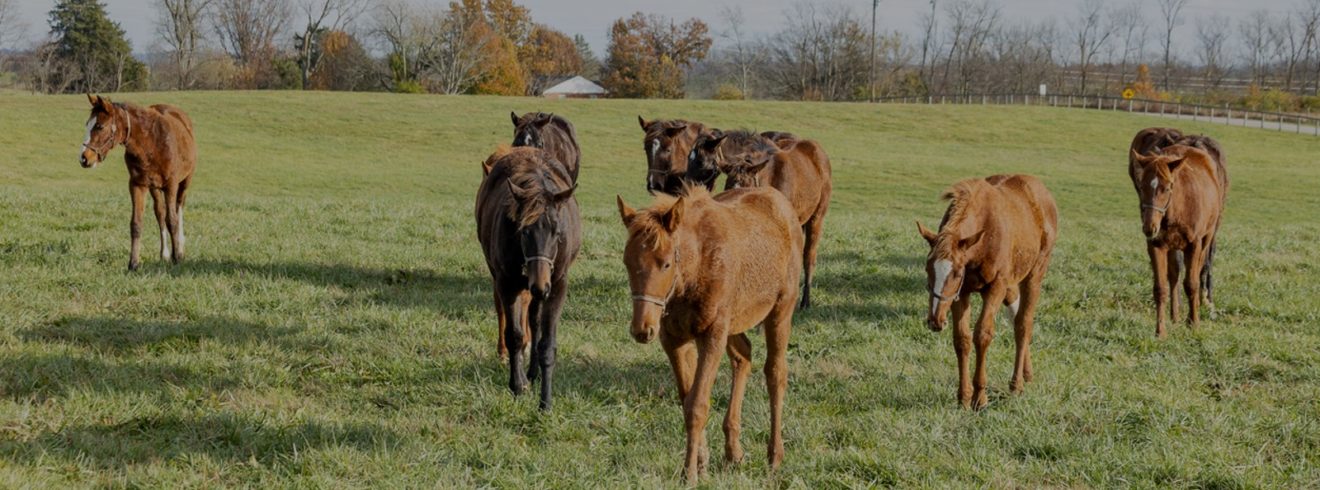Weaning can be seen as a stressful time for Breeding stock and their owners however weaning the foal brings a major benefit to its nutrition; the amount of nutrients provided by the individual dams’ milk is now no longer a concern and as a consequence monitoring feed intake becomes much easier. Gradually introducing appropriate concentrate feed in advance of weaning the foal will help with the transition from suckling/grazing to meal feeding/grazing as the primary source of nutrients in the foal’s diet. The aim of feeding the weanling should be to continue to provide all nutrients for optimum growth whilst maintaining foals in optimum condition, definitely not too heavy, nor too light. The thoroughbred foal is commonly weaned around 6 months of age. This of course can vary from farm to farm and depend on a number of circumstances. This coincides with a period in the foals’ life that is quiet precarious in terms of the incidence of Developmental Orthopaedic Disease (DOD).
Weanlings are generally group fed following the weaning process and a group of weanlings often vary significantly in size and type, some are lighter and leaner whereas others are much stronger and carry more condition. There is an optimum growth rate for the individual weanling that is predetermined genetically. It is really important to monitor growth rates so that changes to the feed can be made as required. Regular assessment of body condition score when checking and feeding the weanlings is all part of good stock management that is inherent on breeding farms. Research also suggests that the height at the withers should also be monitored with the bodyweight so that fast growing individuals can be more easily identified and diets altered accordingly. The easiest way to assess bodyweight is to use a weighbridge and to chart the foal’s weight (and height using a measuring stick) at least once per month. Rapid weight increases should be noted as these foals are more likely to develop signs of DOD. Weanlings already showing signs of DOD should be prevented from achieving further rapid weight gain and maintained preferably on the lighter side to ease pressure on the growth plates. These weanlings should be fed a reduced calorie feed while maintaining their intake of quality amino acids, minerals and vitamins to support continued growth. This can be achieved by using a low calorie nutrient dense feed balancer, which can be fed with chopped lucerne, which also supplies quality fibre and other nutrients. The balance between feeding and exercise is critical as exercise is now known to be important for weanlings to help strengthen up the musculoskeletal system. Grazing presents an opportunity for the intake of key nutrients from pasture and also provides a natural form of exercise. If weanlings are in a stabled environment they will benefit from handwalking daily in addition to turn out time.
The feeding programme should be based upon a balanced, palatable, forage and concentrate diet. It should contain easily digestible ingredients that meet the requirements for growth and development of the foal, but does not oversupply energy in the form of starch. If too much nutrition is provided that is unbalanced, e.g. high levels of energy particularly from starch, then rapid growth can occur. Optimal not maximal nutrition is the key and this should help to produce a healthy individual that optimizes athletic potential for future performance. It is now understood that high starch diets may predispose foals to DOD. Feeding a concentrate with a lower glycaemic index or indeed adding some good quality oil such as soya or linseed oil to a more traditional concentrate can help to reduce the glycaemic response of that feed making it more suitable for growing youngstock.
Care should be taken as excessive dietary energy may result in a rapid growth rate increasing the risk of DOD. With respect to minerals and vitamin requirements these nutrients although required in relatively small amounts can have a significant impact on the normal skeletal growth of the foal, if they are not provided in an available and balanced form. Mineral deficiencies, even slight ones can result in DOD. Deficiencies or imbalances of calcium, phosphorous, copper and zinc will predispose the weanling to these problems. Pastures are simply not guaranteed to provide weanlings with all minerals required and so daily feeding of small amounts of a nutrient dense balancer can ensure that important nutrient requirements are met in a balanced feed. Ideally pasture should be analysed for mineral status so that any deficiencies/ imbalances are known.
The addition of excessive supplements may cause further problems. Please speak to a nutrition advisor or veterinary professional before introduction of supplements to your feeding programme.
Fibre should not be considered as simply a bulk feed or filler, but as a source of energy as the digestive tract of the weanling should now be fully adapted to fibre digestion. An adequate fibre intake will ensure the gut remains healthy and is vital for the overall health of the weanling. Feeding a high quality, early cut hay/haylage will also reduce the chances of “hay-belly”, the characteristic pot bellied appearance often seen in foals fed on mature forage.
Unfortunately, this is sometimes seen in weanlings turned out to pasture in the autumn months as the grass is over mature and stemmy. If the weanling is showing too much of a “hay-belly”, time out at pasture should be restricted. Chopped Lucerne can be offered in addition to good quality hay/haylage.
Attention to detail and careful monitoring of weanlings will help breeders to achieve their goals whether that involves progression through the sales ring or indeed retention of stock until a later age. If you have any queries regarding feeding your foal pre or post weaning please do not hesitate to contact a member of the GAIN Equine Nutrition team.

